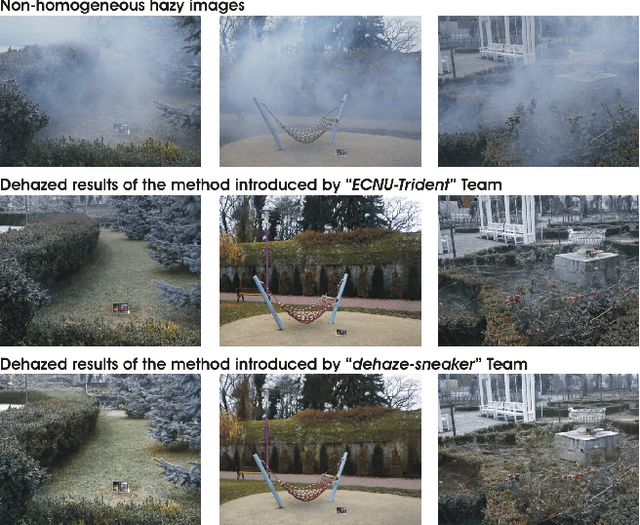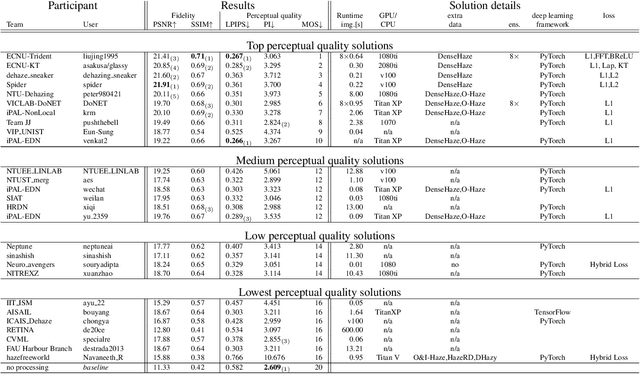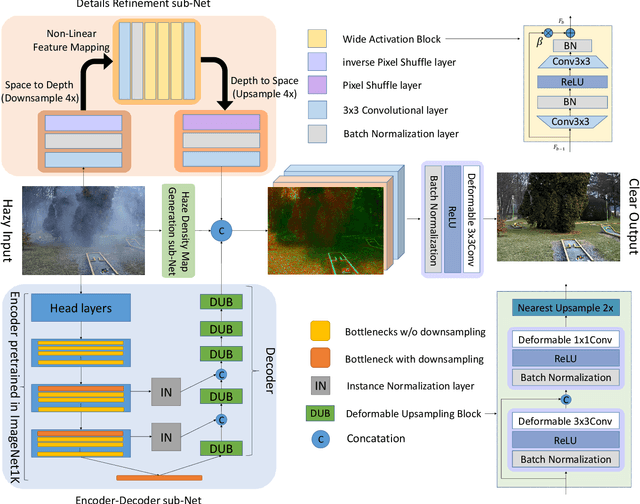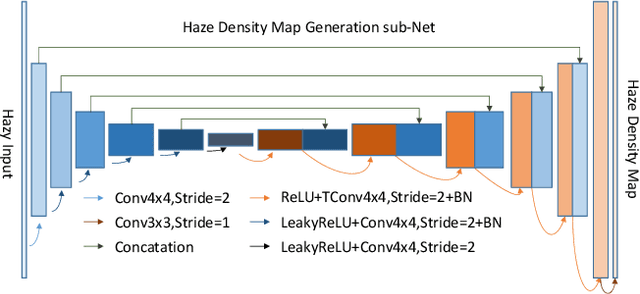Venkateswararao Cherukuri
NTIRE 2020 Challenge on NonHomogeneous Dehazing
May 07, 2020



Abstract:This paper reviews the NTIRE 2020 Challenge on NonHomogeneous Dehazing of images (restoration of rich details in hazy image). We focus on the proposed solutions and their results evaluated on NH-Haze, a novel dataset consisting of 55 pairs of real haze free and nonhomogeneous hazy images recorded outdoor. NH-Haze is the first realistic nonhomogeneous haze dataset that provides ground truth images. The nonhomogeneous haze has been produced using a professional haze generator that imitates the real conditions of haze scenes. 168 participants registered in the challenge and 27 teams competed in the final testing phase. The proposed solutions gauge the state-of-the-art in image dehazing.
Deep MR Brain Image Super-Resolution Using Spatio-Structural Priors
Sep 10, 2019



Abstract:High resolution Magnetic Resonance (MR) images are desired for accurate diagnostics. In practice, image resolution is restricted by factors like hardware and processing constraints. Recently, deep learning methods have been shown to produce compelling state-of-the-art results for image enhancement/super-resolution. Paying particular attention to desired hi-resolution MR image structure, we propose a new regularized network that exploits image priors, namely a low-rank structure and a sharpness prior to enhance deep MR image super-resolution (SR). Our contributions are then incorporating these priors in an analytically tractable fashion \color{black} as well as towards a novel prior guided network architecture that accomplishes the super-resolution task. This is particularly challenging for the low rank prior since the rank is not a differentiable function of the image matrix(and hence the network parameters), an issue we address by pursuing differentiable approximations of the rank. Sharpness is emphasized by the variance of the Laplacian which we show can be implemented by a fixed feedback layer at the output of the network. As a key extension, we modify the fixed feedback (Laplacian) layer by learning a new set of training data driven filters that are optimized for enhanced sharpness. Experiments performed on publicly available MR brain image databases and comparisons against existing state-of-the-art methods show that the proposed prior guided network offers significant practical gains in terms of improved SNR/image quality measures. Because our priors are on output images, the proposed method is versatile and can be combined with a wide variety of existing network architectures to further enhance their performance.
Deep MR Image Super-Resolution Using Structural Priors
Sep 10, 2018



Abstract:High resolution magnetic resonance (MR) images are desired for accurate diagnostics. In practice, image resolution is restricted by factors like hardware, cost and processing constraints. Recently, deep learning methods have been shown to produce compelling state of the art results for image super-resolution. Paying particular attention to desired hi-resolution MR image structure, we propose a new regularized network that exploits image priors, namely a low-rank structure and a sharpness prior to enhance deep MR image superresolution. Our contributions are then incorporating these priors in an analytically tractable fashion in the learning of a convolutional neural network (CNN) that accomplishes the super-resolution task. This is particularly challenging for the low rank prior, since the rank is not a differentiable function of the image matrix (and hence the network parameters), an issue we address by pursuing differentiable approximations of the rank. Sharpness is emphasized by the variance of the Laplacian which we show can be implemented by a fixed {\em feedback} layer at the output of the network. Experiments performed on two publicly available MR brain image databases exhibit promising results particularly when training imagery is limited.
 Add to Chrome
Add to Chrome Add to Firefox
Add to Firefox Add to Edge
Add to Edge